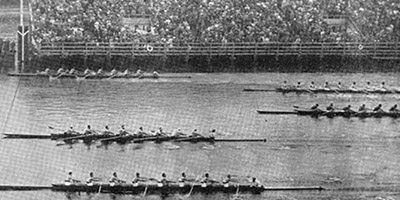Rowing is a team sport and so is product development. Why is this an important idea? A couple years ago I read the book The Boys In The Boat (Danial James Brown, Penguin Books, 2014) and I learned about the concept of “swing.” Swing is when all eight oarsmen are rowing in such perfect unison that no single action by any one is out of synch with those of all the others… Only then will the boat continue to run, unchecked, fluidly and gracefully between the pulls of the oars” (Teams of Distinction) As I developed this post it made me think about a quote in the book about “swing”:
“When you get the rhythm in an eight, it’s pure pleasure to be in it. It’s not hard work when the rhythm comes – that “swing” as they call it. I’ve heard men shriek… when that swing comes in an eight; it’s a thing they’ll never forget as long as they live.” – George Pocock, shell builder
"Swing"
The equivalent of “swing” in Lean Product Development is “Cadence, Pull, and Flow.” Cadence is clear – regular intervals. Cadence instills a discipline of communication and collaboration leading to team cohesion. We at Rapiscan|AS&E achieve this through the Agile Scrum process of 3-week sprints and scrums 3-times a week. Pull is a little more elusive as it requires the person down-stream in the value stream to tell their up-stream partner what they need (and the up-stream partner to fulfill this need). In Agile Scrum this is achieved in the prioritized backlog. Flow is the hardest to define and the most elusive to achieve. “Flow,” in the product development sense, is the feeling that everything is running in sync – that there is no start/stop, just continuous work output. This is not that you are constantly working (busy), but that you know that value is being created and that the team can sense and see that they are progressing towards completion and success.

PD Journey
When we started our lean PD journey about six years ago, I understood the definition of flow, but I did not know what it was until years later. Our start in lean PD did include cadenced team meetings. This was a great improvement over point-reviews, schedule when ready or on a whim, often resulting in meeting conflicts and impromptu meetings with little time to prepare. The cadenced reviews set an expectation of communication and collaboration. But our cadenced meetings were focused on the technical issues and did not include project progress.
About 18-months ago many members of our team were formally trained in the Agile Scrum method. We were “certified” Scrum Masters! For the next 12 months, we struggled with making Agile Scrum work for us. Then, six months of more work, and now I can “feel” the flow. How did we achieve it?
- Cadence: we meet every 3-weeks to plan our next sprint
- Pull: we pick just enough work from the backlog that we can complete it in the next sprint
- Cadence: We meet M/W/F for a scrum. The scrum format is the same every meeting. We review and work only on the tasks identified for the 3-week sprint
- At the end of each sprint, we discuss how we did and suggest changes on how we will operate during the next sprint. A cycle of improvement is “built in” to the way we work
- Repeat
Over 18 months, that is 72 cycles of learning! Suddenly, it dawns on me that we are just rolling out value. And we are rolling out more value per unit of time than we did 18 months ago.
I can’t say that I know exactly what swing is in a boat, but I believe the flow we are achieving at Rapiscan|AS&E is in some small manner related to this feeling. And it feels good
The quote above was sourced from this article I found at achieveit.com. Boys in the Boat: 10 Lessons on Strategy Execution, Teamwork

